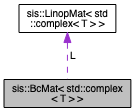|
| | BcMat () |
| |
| | BcMat (int m_, int n_) |
| |
| void | resize (int m_, int n_) |
| |
| void | operator= (const BcMat< std::complex< T > > &in) |
| |
| int | rows () |
| |
| int | cols () |
| |
| Eigen::Matrix< std::complex< T >, Eigen::Dynamic, Eigen::Dynamic > | operator() (int i, int j, int ord) |
| | Calling BcMat(i,j, ord) will produce row vector representing [---—][a0 a1 ... an C0 C1]^T, assuming ord = 2. i and j refers to an element in the LinopMat L. Suppose L(1,1) is Dyy, and eval(1,1) = -1, then the row matrix will represent the evaluation of that condition in the basis of a0 to C1. More...
|
| |
template<class T>
class sis::BcMat< std::complex< T > >
Definition at line 8918 of file sis.hpp.
template<class T >
| Eigen::Matrix<std::complex<T>, Eigen::Dynamic, Eigen::Dynamic> sis::BcMat< std::complex< T > >::operator() |
( |
int |
i, |
|
|
int |
j, |
|
|
int |
ord |
|
) |
| |
|
inline |
Calling BcMat(i,j, ord) will produce row vector representing [---—][a0 a1 ... an C0 C1]^T, assuming ord = 2. i and j refers to an element in the LinopMat L. Suppose L(1,1) is Dyy, and eval(1,1) = -1, then the row matrix will represent the evaluation of that condition in the basis of a0 to C1.
Definition at line 8979 of file sis.hpp.
References sis::MatGen< T >::compute(), sis::MatGen< T >::con_mats, sis::BcMat< T >::eval, sis::BcMat< T >::L, sis::MatGen< T >::mats, sis::N, and sis::BcMat< T >::vals.

